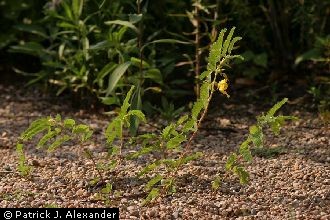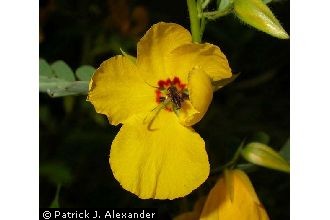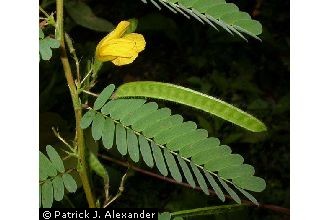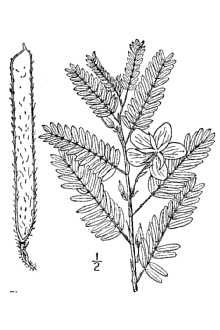Partridge Pea
Scientific Name: Chamaecrista fasciculata (Michx.) Greene
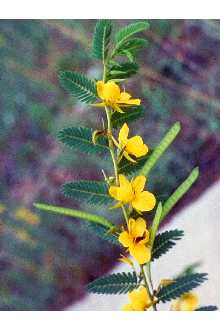
| General Information | |
|---|---|
| Usda Symbol | CHFA2 |
| Group | Dicot |
| Life Cycle | Annual |
| Growth Habits | Forb/herb |
| Native Locations | CHFA2 |
Plant Guide
Description
General: Pea Family (Fabaceae). Partridge pea is an annual sub-erect native legume plant that reaches a height of 1 to 3 feet. The leaves consist of 10 to 15 pairs of small, narrow leaflets that are somewhat delicate to the touch. The showy yellow flowers, about 1 inch across, grow 2 to 4 together in clusters on the stem. Flowers normally bloom July-September. The fruit is a straight, narrow pod 1½ to 2½ inches long, which splits along 2 sutures as it dries; the pod sides spiral to expel the seeds some distance from the parent plant. Distribution: For current distribution, please consult the Plant Profile page for this species on the PLANTS Web site. Habitat: Partridge pea grows on prairies, bluffs, riverbanks and river bottoms, as well as upland woods of the Great Plains. Partridge pea is common on sandy savannahs of the lower Gulf Coastal Plain. Partridge pea is most common on sandy to sandy loam soils. It grows best in full sunlight but will survive under shady conditions. Partridge pea has low water requirements and will grow and produce seed under stressed conditions. The lower pH limit of showy partridge pea is 5.0.
Adaptation
The USDA hardiness zones for showy partridge pea are 3 to 9. It is distributed throughout the Midwest, eastern, and southern United States.
Uses
Wildlife: The seed is one of the major food items of northern bobwhite and other quail species because it remains in sound condition throughout the winter and early spring. Partridge pea was found to be one of the most important fall and winter foods of bobwhite quail in Alabama. Partridge pea seeds are high in phosphorus content and protein value, and low in crude fiber and lignin making digestibility generally high. Seeds of this legume are also eaten by the greater and lesser prairie-chicken, ring-necked pheasant, mallard, grassland birds, and field mice. Partridge pea often grows in dense stands, producing litter and plant stalks that furnish cover for upland game birds, small mammals, small non-game birds, and waterfowl. Partridge pea is considered an important honey plant, often occurring where few other honey plants are found. Nectar is not available in the flowers of showy partridge pea but is produced by small orange glands at the base of Natural Resources Conservation Service Plant Guide John M. Row, USDA-NRCS Manhattan Plant Materials Center each leaf. Ants often seek the nectar and are frequent visitors. The common sulfur butterfly lays its eggs on the leaves, and the larvae use the leaves as a food source. Erosion control: The plant can be used along road banks and stream banks to control erosion. Partridge pea most commonly occurs as a pioneer or colonizer of disturbed areas. Recreation and beautification: The flowers of this plant can be used to beautify areas where wildflowers are planted. The foliage is sensitive. Partridge pea is commonly grown as an ornamental. The bright yellow flowers make it a popular choice for use in native gardens. Restoration: Partridge pea is considered an excellent species for planting on disturbed areas for erosion control and improving soil fertility. It establishes rapidly, fixes nitrogen, reseeds, and slowly decreases as other species in the seeding mix begin to dominate the site. Nitrogen fixation is greatest during the flowering stage. To help prevent weed establishment and control soil erosion along county roadsides in Iowa, partridge pea is often included in the seed mix with other forbs and grasses.
Ethnobotany
Cherokee Drug (Sports Medicine): root medicine used to keep ball players from tiring. Cherokee Drug (Stimulant): compound infusion given for fainting spells. Seminole Drug (Antiemetic): cold decoction of plant used for nausea. Seminole Other (Tools): plants used as a bed for ripening persimmons.
Status
This plant may become weedy or invasive in some regions or habitats and may displace desirable vegetation if not properly managed. Please consult with your local NRCS Field Office, Cooperative Extension Service office, state natural resource, or state agriculture department regarding its status and use. Please consult the PLANTS Web site (http://plants.usda.gov/) and your state’s Department of Natural Resources for this plant’s current status (e.g., threatened or endangered species, state noxious status, and wetland indicator values).
Planting Guidelines
Drill seeds at ¼ to ¾ inch at a rate of 10-15 pounds of Pure live Seed (PLS) per acre. If broadcasting seeds, the rate should be increased and covered by lightly disking or cultipacking. Partridge pea is planted from late winter (March) to late spring (May). Scarification improves germination of seed, but it is not necessary for establishment of partridge pea. Seed should also be inoculated with the correct rhizobium before planting. Fertilizer should be applied based on soil test recommendations.
Management
A light disking in the spring is necessary to ensure soil contact for volunteer reseeding. Partridge pea usually reseeds but will gradually disappear without regular maintenance. Fire or disking is performed in late winter to control unwanted vegetation. Weeds are controlled during the growing season by mowing or selective herbicides.
Pests and Potential Problems
No known pest and potential problems.
Control
Please contact your local agricultural extension specialist or county weed specialist to learn what works best in your area and how to use it safely. Always read label and safety instructions for each control method. Trade names and control measures appear in this document only to provide specific information. USDA NRCS does not guarantee or warranty the products and control methods named, and other products may be equally effective.
Seeds and Plant Production
Plant Production
Plant Production
Partridge pea germination is improved with cold moist stratification for 8 weeks. In a growth chamber, germination occurs at an alternating cycle of 30oC daytime and 15oC nighttime temperatures. Optimum soil temperature for germination is 20o to 30oC. Seventy percent of seeds will germinate in 7 to 25 days. There are 62,000 partridge pea seeds per pound.
Literature Cited
Ajilvsgi, G. 1991. Wildflowers of Texas. Shear Publishing, Fredericksburg, Texas. Englert, J. M. et al. 1999–. USDA-NRCS improved conservation plant materials released by NRCS and cooperators. USDA NRCS National Plant Materials Center, Beltsville, Maryland. Graham, E. H. 1941. Legumes for erosion control and wildlife. USDA Misc. Publ. 412. (Leg ErWild) Green, D.L., Plant pollinator web site. (http://pollinator.com/index.html), 22 March 2006. Haddock, M. 2004. Kansas wildflowers and grasses. (http://www.lib.ksu.edu/wildflower/), 7 March 2006. Kansas State University, Manhattan. Hamel, P.B. and M.U. Chiltoskey. 1975. Cherokee Plants and Their Uses -- A 400 Year History. Sylva, N.C. Herald Publishing Co. 54p. Native Plant Information Network. 2001. Propagation datasheets (http://www.wildflower2.org/NPIN/Clearinghouse/Propagation/propsheets.html, 7 March 2006). Lady Bird Johnson Wildflower Center, Austin. Samuel Roberts Noble Foundation Plant image gallery. (http://www.noble.org/WebApps/PlantImageGallery/Plant.aspx?PlantID=101&PlantTypeID=1). Accessed: 6 March 2006. Ardmore, OK. North Carolina Department of Transportation. Wildflowers on North Carolina Roadsides, (http://www.ncdot.org/doh/operations/dpeng/roadside/wildflowerbook/. Raleigh. Sturtevant, W. 1954. The Mikasuki Seminole: Medical beliefs and practices. Yale University, PhD Thesis (p. 276, 496). Tesky, J.L. 1992. Cassia fasciculata. In: Fire Effects Information System, [Online]. (http://www.fs.fed.us/database/feis/, 7 March 2006). U.S. Department of Agriculture, Forest Service Texas Agricultural Experiment Station, 1986. Comanche Partridge Pea. L221. 4p. Texas A&M University System, College Station. USDA NRCS Jamie L Whitten Plant Materials Center. Notice of release: Lark selection partridge pea. (http://plant-materials.nrcs.usda.gov/pubs/mspmcrnchfa2.pdf) USDA-NRCS Jamie L. Whitten Plant Materials Center, Coffeeville, MS. 3p. USDA NRCS James E. ‘Bud’ Smith Plant Materials Center. Notice of release: “Comanche” partridge pea. (http://plant-materials.nrcs.usda.gov/pubs/txpmcrnchfa2.pdf) USDA-NRCS James E. ‘Bud’ Smith Plant Materials Center, Knox City, TX, 2p. USDA NRCS Manhattan Plant Materials Center. Notice of release: ‘Riley’ showy partridge pea. (http://plant-materials.nrcs.usda.gov/pubs/kspmcrnchfa2.pdf) USDA-NRCS Plant Materials Center, Manhattan, KS. 8p.
Conservation
District at http://www,nrcs,usda,gov/ and visit the PLANTS Web site at http://plants,usda,gov/ or the Plant Materials Program web site: http://plant-materials,nrcs,usda,gov, PLANTS is not responsible for the content or availability of other Web sites, In accordance with Federal civil rights law and U,S, Department of Agriculture (USDA) civil rights regulations and policies, the USDA, its Agencies, offices, and employees, and institutions participating in or administering USDA programs are prohibited from discriminating based on race, color, national origin, religion, sex, gender identity (including gender expression), sexual orientation, disability, age, marital status, family/parental status, income derived from a public assistance program, political beliefs, or reprisal or retaliation for prior civil rights activity, in any program or activity conducted or funded by USDA (not all bases apply to all programs), Remedies and complaint filing deadlines vary by program or incident, Persons with disabilities who require alternative means of communication for program information (e,g,, Braille, large print, audiotape, American Sign Language, etc,) should contact the responsible Agency or USDA's TARGET Center at (202) 720-2600 (voice and TTY) or contact USDA through the Federal Relay Service at (800) 877-8339, Use soil moisture sensors to measure the soil moisture of Partridge Pea., Additionally, program information may be made available in languages other than English, To file a program discrimination complaint, complete the USDA Program Discrimination Complaint Form, AD-3027, found online at How to File a Program Discrimination Complaint and at any USDA office or write a letter addressed to USDA and provide in the letter all of the information requested in the form, To request a copy of the complaint form, call (866) 632-9992, Submit your completed form or letter to USDA by: (1) mail: U,S, Department of Agriculture, Office of the Assistant Secretary for Civil Rights, 1400 Independence Avenue, SW, Washington, D,C, 20250-9410; (2) fax: (202) 690-7442; or (3) email: program,intake@usda,gov, USDA is an equal opportunity provider, employer, and lender,
Plant Traits
Growth Requirements
| Cold Stratification Required | No |
|---|---|
| Frost Free Days, Minimum | 130 |
| Frost Free Days, Minimum | 130 |
| Fire Tolerance | None |
| Fire Tolerance | None |
| Fertility Requirement | Medium |
| Fertility Requirement | Medium |
| Drought Tolerance | Medium |
| Drought Tolerance | Medium |
| Cold Stratification Required | No |
| Temperature, Minimum (°F) | -3 |
| CaCO3 Tolerance | Low |
| Anaerobic Tolerance | None |
| Anaerobic Tolerance | None |
| Adapted to Medium Textured Soils | Yes |
| Adapted to Medium Textured Soils | Yes |
| Adapted to Fine Textured Soils | No |
| Adapted to Fine Textured Soils | No |
| Adapted to Coarse Textured Soils | Yes |
| Adapted to Coarse Textured Soils | Yes |
| Hedge Tolerance | None |
| Temperature, Minimum (°F) | -3 |
| Shade Tolerance | Tolerant |
| Shade Tolerance | Intolerant |
| Salinity Tolerance | None |
| Salinity Tolerance | Low |
| Root Depth, Minimum (inches) | 14 |
| Root Depth, Minimum (inches) | 14 |
| Precipitation, Minimum | 14 |
| Precipitation, Minimum | 14 |
| Precipitation, Maximum | 65 |
| Precipitation, Maximum | 45 |
| pH, Minimum | 6.5 |
| pH, Minimum | 5.5 |
| pH, Maximum | 7.5 |
| pH, Maximum | 7.5 |
| Moisture Use | Medium |
| Moisture Use | Medium |
| Hedge Tolerance | None |
Morphology/Physiology
| Active Growth Period | Spring |
|---|---|
| Toxicity | Slight |
| Toxicity | Slight |
| Shape and Orientation | Erect |
| Shape and Orientation | Erect |
| Fire Resistant | No |
| Foliage Porosity Winter | Porous |
| Foliage Porosity Summer | Moderate |
| Foliage Porosity Summer | Dense |
| Foliage Color | Green |
| Foliage Color | Green |
| Flower Conspicuous | Yes |
| Flower Conspicuous | Yes |
| Flower Color | Yellow |
| Flower Color | Yellow |
| Fire Resistant | No |
| Resprout Ability | No |
| Fall Conspicuous | No |
| Fall Conspicuous | No |
| Coppice Potential | No |
| Coppice Potential | No |
| C:N Ratio | Low |
| C:N Ratio | Low |
| Bloat | None |
| Bloat | Low |
| Active Growth Period | Spring |
| Resprout Ability | No |
| Foliage Texture | Fine |
| Nitrogen Fixation | Medium |
| Nitrogen Fixation | High |
| Low Growing Grass | No |
| Low Growing Grass | No |
| Leaf Retention | No |
| Leaf Retention | No |
| Known Allelopath | No |
| Known Allelopath | No |
| Height, Mature (feet) | 2.4 |
| Height, Mature (feet) | 2.0 |
| Growth Rate | Rapid |
| Growth Rate | Rapid |
| Foliage Porosity Winter | Porous |
| Foliage Texture | Medium |
| Fruit/Seed Color | Black |
| Fruit/Seed Color | Brown |
| Fruit/Seed Conspicuous | No |
| Fruit/Seed Conspicuous | No |
| Growth Form | Bunch |
| Growth Form | Bunch |
Reproduction
| Propagated by Cuttings | No |
|---|---|
| Propagated by Seed | Yes |
| Propagated by Seed | Yes |
| Propagated by Sod | No |
| Propagated by Sod | No |
| Propagated by Sprigs | No |
| Propagated by Sprigs | No |
| Propagated by Tubers | No |
| Fruit/Seed Persistence | No |
| Propagated by Tubers | No |
| Seed per Pound | 65000 |
| Seed per Pound | 65000 |
| Seed Spread Rate | Rapid |
| Seed Spread Rate | Rapid |
| Seedling Vigor | High |
| Seedling Vigor | High |
| Small Grain | No |
| Small Grain | No |
| Vegetative Spread Rate | None |
| Vegetative Spread Rate | None |
| Propagated by Corm | No |
| Propagated by Cuttings | No |
| Bloom Period | Early Summer |
| Bloom Period | Early Summer |
| Commercial Availability | Routinely Available |
| Commercial Availability | Routinely Available |
| Fruit/Seed Abundance | High |
| Fruit/Seed Abundance | High |
| Fruit/Seed Period Begin | Summer |
| Fruit/Seed Period Begin | Summer |
| Fruit/Seed Period End | Summer |
| Fruit/Seed Persistence | No |
| Propagated by Bare Root | No |
| Propagated by Bare Root | No |
| Propagated by Bulb | No |
| Propagated by Bulb | No |
| Propagated by Container | No |
| Propagated by Container | No |
| Propagated by Corm | No |
| Fruit/Seed Period End | Summer |
Suitability/Use
| Palatable Browse Animal | Medium |
|---|---|
| Palatable Graze Animal | High |
| Palatable Graze Animal | Medium |
| Palatable Human | No |
| Palatable Human | No |
| Post Product | No |
| Post Product | No |
| Protein Potential | High |
| Protein Potential | High |
| Pulpwood Product | No |
| Pulpwood Product | No |
| Veneer Product | No |
| Veneer Product | No |
| Palatable Browse Animal | High |
| Nursery Stock Product | No |
| Nursery Stock Product | No |
| Naval Store Product | No |
| Naval Store Product | No |
| Lumber Product | No |
| Lumber Product | No |
| Fodder Product | Yes |
| Fodder Product | No |
| Christmas Tree Product | No |
| Christmas Tree Product | No |
| Berry/Nut/Seed Product | No |
| Berry/Nut/Seed Product | No |

